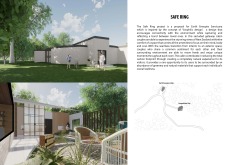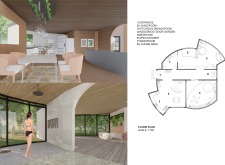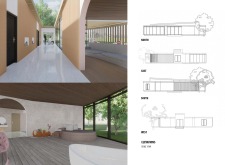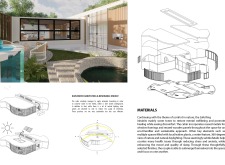5 key facts about this project
Design Approach: Biophilic Integration and Sustainability
A defining characteristic of the Safe Ring project is its commitment to biophilic design principles. The architectural layout encourages visual and physical access to the surrounding natural environment, achieved through large glass windows and open spaces. This integration allows natural light to permeate the interiors, enhancing the overall atmosphere.
Sustainability is another cornerstone of this design. The project incorporates reused metals for structural components, wooden panels for warmth, and natural stones for pathways. These materials not only contribute to the aesthetic appeal but also support eco-friendly construction practices. Energy efficiency is prioritized through features such as solar panels and rainwater harvesting systems.
The layout consists of interconnected areas that facilitate interaction while providing zones for privacy. Important components of the sanctuary include a welcoming entrance, a central living room, a combined kitchen and dining area, and an indoor/outdoor garden. The design also features a cohesive outdoor living space, complete with water elements that contribute to the peaceful ambiance.
Spatial Design: Experience and Functionality
The Safe Ring project embodies a thoughtful approach to spatial organization. The interior spaces are designed to flow seamlessly from one to another, reinforcing a sense of connectedness among occupants. The living room serves as a central hub, promoting social interactions, while the bedroom offers a secluded retreat for tranquility.
In addition to standard amenities, innovative design features such as an open shower allow for an unobstructed connection to the outdoor environment, enhancing the sensory experience for residents. The strategic placement of outdoor areas invites occupants to engage with their surroundings, increasing their awareness of natural processes and fostering an appreciation for the local ecology.
Uniqueness in Design
What distinguishes the Safe Ring from conventional architectural designs is its holistic focus on the human experience within nature. Rather than merely providing a physical structure, this project emphasizes the relationship between individuals and their environment. By incorporating sustainable materials and fostering intimate living spaces, the Safe Ring fulfills a dual purpose: it serves as a functional retreat and a beacon of contemporary ecological architecture.
The creative design choices reflect a commitment to enriching the occupants' experience while maintaining a minimal ecological footprint. Innovations such as the incorporation of biophilic elements and the harmonization with the natural landscape illustrate a forward-thinking approach within the realm of residential architecture.
For an in-depth examination of the architectural plans, sections, and overall designs, explore the project presentation to gain further insights into this unique architectural endeavor.


























